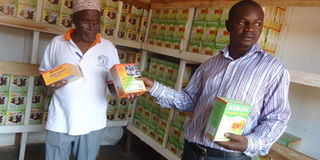COMESA vs EU: What market for Uganda’s products?

Members of a farmers’ association with boxes of dried fruit they export. While most producers in Uganda focus on Europe and US for export, there is a lucrative market for their products with Africa’s trade blocs that needs to be exploited. FILE PHOTO
What you need to know:
For many of the agricultural products from Uganda, we may not need to look for markets far beyond the borders
The annual International Trade Fair kicked off at the Uganda Manufacturers’ Association showground in Kampala last week and it was impressive to see all these Small and Medium Enterprises (SMEs) putting up a show of strength, purpose and focus.
Many of these SMEs are in the agriculture sector and majorly focusing on adding value to the products, which have for long been consumed at their most basic level.
A talk to these exhibitors reveals their keen interest to export to the European and American markets as soon as possible.
Stringent regulations
They cite a number of challenges that they are trying to overcome in order to not only appeal to those markets but also conform to their expectations.
With all due respect, while these markets have a primary responsibility of ensuring that their consumers are not exposed to contaminated foods, it is also believed that in a bid to protect their highly subsidised farmers, such stringent regulations are put in place.
While the price offers for products with access to the markets in the European Union (EU) tend to be lucrative, this incentive is wiped away by the levels of investment required, which are usually way out of reach of the average SME in Uganda. There are lots of expectations on how the products are processed and packaged.
A look at the Comesa—Common Market for Eastern and Southern Africa—region speaks a lot about the market potential that lies ahead for Uganda’s agro entrepreneur.
Lucrative and hassle-free
According to the Comesa Trade Statistics bulletin of 2013, the bloc has a population of 458.6 million people dwarfing that of the US by at least 100 million people.
The overall gross domestic product (GDP) of the regional bloc is $571.8b. Intra-Comesa exports are valued at $9.3b while the intra-Comesa imports are at $10b.
This is a potentially lucrative and hassle-free market save for other impediments like transportation and distribution of products at the regional level. During the same period under investigation, intra-Comesa trade contributed a share of 14 per cent to Uganda’s total trade and was valued at $1.2b.
Why would an SME undertake massive investments just to appeal to the EU market when there is an opportunity to perfect and harness the regional markets?
Apart from a few select products like flowers that are mainly lucrative in the West, various other agricultural products already have a great regional appeal like tea, maize, coffee, animals, tobacco, fish and sugar.
In 2012, Uganda joined the Comesa Free Trade Area, another reason to encourage local entrepreneurs to target the regional bloc market.
Look at the region
What this means is that the tarrifs imposed on the majority of imports and exports between Uganda and other Comesa countries will drop to 0 per cent. This is likely to have a net effect of improving the competitiveness of our goods and act as the icing on the cake.
This is considering that the country has the lowest cost of production in agriculture and is within easy reach of some of the economies that depend highly on the Comesa bloc like DR Congo at 24 per cent, Rwanda at 34 per cent and Burundi at 19 per cent.
For an agro-focused SME involved in any form of value addition or raw product trade, it is high time that serious consideration was given to the Comesa region and the benefits will be seen.
The game is likely to get even better when the Tripartite Free Trade Area is implemented, which will see tarrifs revised downwards between Comesa, East African Community (EAC) and Southern Africa Development Community (SADC) trade blocs. This will extend our reach to 27 countries and a population of over 800 million people. The writer is an agro, ICT and business consultant. Follow @wirejames




